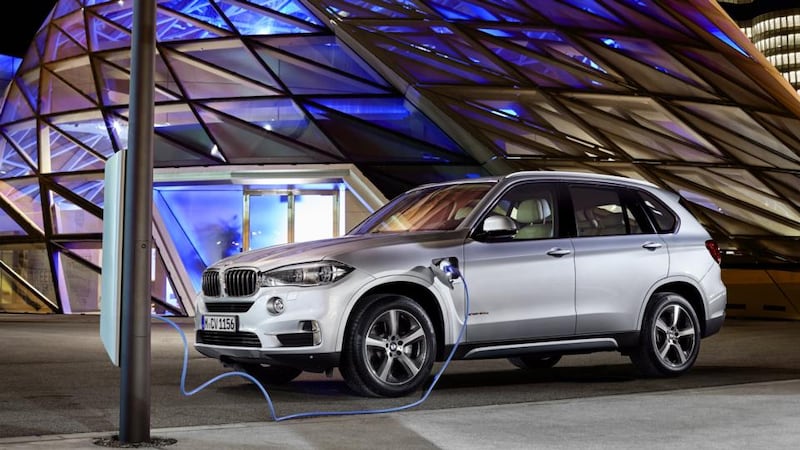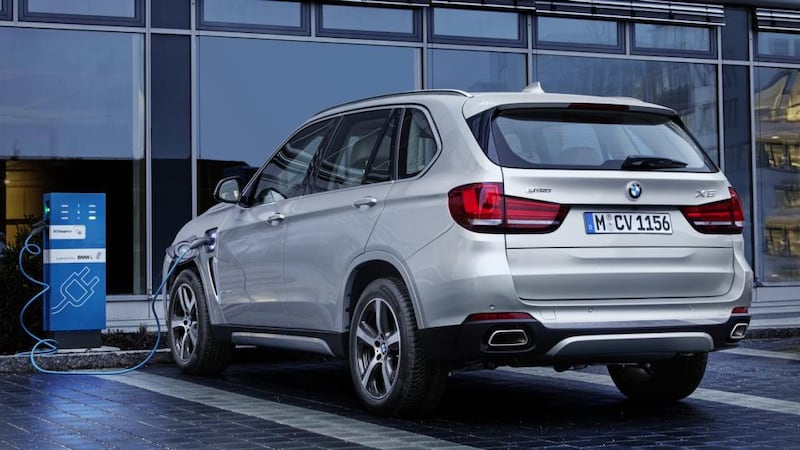BMW may just have answered the prayers of well-heeled south Dublin suburban families courtesy of its latest X5 variant. With the introduction of its new plug-in hybrid eDrive, owners no longer need to feel any eco-angst for opting for the large premium SUV.
Thanks to technology taken from BMW’s impressive i8 supercar, this X5 eDrive delivers the performance and practicality of a fully-fledged SUV (including four-wheel drive and towing capabilities) while boasting an official CO2 emissions figure of 77g/km. To put that in perspective, that’s lower than any Ford Fiesta or even any Volkswagen Up currently on sale in Ireland.
And with the chance to drive up to 31km on full electric power, owners can cruise through town in their X5 with the same self-righteousness of any cyclist.


This is the first plug-in hybrid to feature in the core brand at BMW, but it will be closely followed by similar plug-in hybrid versions of the new 3-Series, the 7-Series and invariably most, if not all, of the range as models get facelifted or replaced.
Third row out
There are some sacrifices compared with the regular X5. For a start, the battery pack is fitted under the rear floor, which means you can’t opt for the third row of seats. That’s a pity, for the seven-seat option is a firm favourite of Irish X5 owners. The 9kw/h batty pack and wiring adds up to 120kgs to the car, but boot space is still impressive, with 500 to and 1,720 litres available and room for four well-filled golf bags in the boot even with the rear seats in use.
The most impressive feature of the X5 eDrive is the powertrain. It’s hard to believe this big SUV has a four-cylinder, 2-litre petrol up front, particularly when you accelerate, and it’s supported by the 113bhp electric motor. In total, the petrol-electric combination offers up 313bhp and 450Nm of torque, with a 0-100km/h time of just 6.8 seconds. This impressive acceleration is evident from the moment you kick down the throttle.
By matching the electric power with the range of the petrol engine, BMW claims a total 830km range between refuelling for this car. The official average fuel economy figures are equally eye-catching: 3.3 l/100km or 85.6 mpg.
As with all plug-in hybrids, the battery can recharge from excess output from the engine and recuperation from braking. Or it can be fully charged by plugging it in via a regular power socket or one of the car recharging stations continually being rolled out by the ESB. These are either public points or private recharging points fitted by the ESB at owner's homes or workplaces. It takes on average 3½ hours to recharge the battery from empty.
The eDrive system offers three driving modes. First up is “save battery”, which uses recuperation to recharge and maintain a 50 per cent charge. This is important in countries where congestion charges apply and electric vehicles are exempt, or where electric cars can use bus lanes in urban areas. The ability to switch to electric-only power will save owners money.
Max eDrive
The next mode is electric-only “Max eDrive”. As mentioned, this has a max range of 31km on a full charge, but that greatly depends on how you drive. In urban areas with little traffic and maintaining speeds of 50km/h or less, you will get the promised 31km range. But try and run on electric-only power on the motorway at 120km/h and you will be lucky to get half that.
The final mode is “Auto eDrive”, which is where the hybrid comes into its own. This mixes engine power with additional acceleration from the battery when needed to best effect and proves itself to be one of the smoothest hybrids we’ve driven to date. The switch between electric and combustion engine power is hard to notice and the whole system works really well with the eight-speed automatic transmission from ZF.
And the driving mode options don’t end there: as with most BMWs, you can move between Comfort, Sport and Eco-Pro driving modes, adjusting the steering, suspension and throttle response accordingly.
For Irish buyers, there is an annoying issue about this car, however: the emissions of 77g/km are two grams over the limit set by Sustainable Energy Authority of Ireland to warrant a €5,000 grant for electric vehicles. Those extra two grammes on the X5 eDrive means buyers only receive a €2,500 rebate on the Vehicle Registration Tax.
In truth, that’s not going to turn off too many potential buyers. And we can’t see too many politicians taking up the campaign for the unfortunate but well-heeled motorists who can’t save €2,500 on their new €71,170 car.
That price is certainly strong enough to lure a substantial quota of buyers to eDrive. After all, the entry-level X5 starts at €66,060 for the two-wheel drive 25d sDrive SE version. Add four-wheel drive to the 2.5d and the price rises to €72,760, more than the net price you’ll pay for the new eDrive version.
Four-wheel for most
According to Michael Nugent, BMW Ireland's director of sales and marketing, the mix of X5 owners shows 58 per cent opt for four-wheel drive (xDrive) on their new cars. In terms of specification, 49 per cent opt for the entry-level SE trim, compared with 51 per cent for the higher-end M Sport pack. The latter is available on the eDrive model for €80,450.
The X5 eDrive arrives in Irish showrooms towards the end of October; expectations are for the sale of 150 eDrive models in a full year.
The X5 eDrive marks the start of a hybrid boom in the BMW ranks. It’s an impressive introduction to the format that will work particularly well for the brand in the US. Irish buyers will be lured by the relatively attractive price and the impressive performance, albeit with sales limited by the fact you can’t get it in seven- seat format.
The lowdown: BMW X5 eDrive
Powertrain: 1997cc 245bhp four-cylinder petrol engine putting out 350Nm of torque, combined with an electric motor putting out 113bhp and 250Nm of torque
Transmission: eight-speed steptronic automatic
Battery recharging: 3 hours
Electric-only range: 31km (with a max speed of 120km/h when in electric-only mode)
Total range (petrol and electric): 830km
Emissions: 77g/km
Fuel economy: 3.3 l/100km (85.6 mpg)
Prices: €73,760 for SE (€71,170 after SEAI grant of €2,500); €80,450 for M Sport (€77,950 after SEAI grant)
Arriving in Ireland: Oct/Nov















